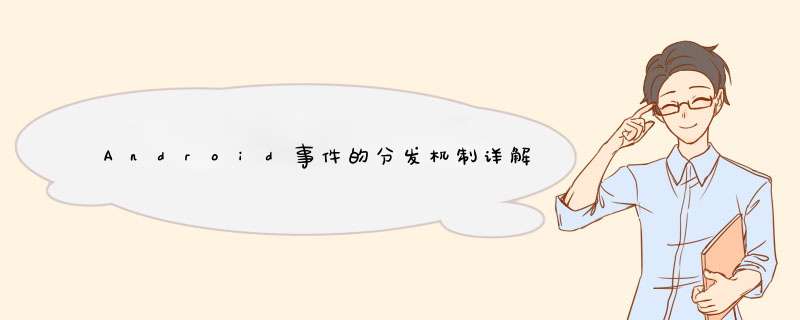
在分析AndroID事件分发机制前,明确androID的两大基础控件类型:VIEw和VIEwGroup。VIEw即普通的控件,没有子布局的,如button、TextVIEw. VIEwGroup继承自VIEw,表示可以有子控件,如linearlayout、ListvIEw这些。今天我们先来了解VIEw的事件分发机制。
先看下代码,非常简单,只有一个button,分别给它注册了OnClick和Ontouch的点击事件。
btn.setonClickListener(new VIEw.OnClickListener() { @OverrIDe public voID onClick(VIEw v) { Log.i("Tag","This is button onClick event"); } }); btn.setontouchListener(new VIEw.OntouchListener() { @OverrIDe public boolean ontouch(VIEw v,MotionEvent event) { Log.i("Tag","This is button ontouch action" + event.getAction()); return false; } });运行一下项目,结果如下:
I/Tag: This is button ontouch action0
I/Tag: This is button ontouch action2
I/Tag: This is button ontouch action2
I/Tag: This is button ontouch action1
I/Tag: This is button onClick event
可以看到,ontouch是有先于onClick执行的,因此事件的传递顺序是先ontouch,在到OnClick。具体为什么这样,下面会通过源码来说明。这时,我们可能注意到了,ontouch的方法是有返回值,这里是返回false,我们将它改为true再运行一次,结果如下:
I/Tag: This is button ontouch action0
I/Tag: This is button ontouch action2
I/Tag: This is button ontouch action2
I/Tag: This is button ontouch action2
I/Tag: This is button ontouch action1
对比两次结果,我们发现onClick方法不再执行,为什么会这样,下面我将通过源码给大家一步步理清这个思路。
查看源码时,首先要知道所有VIEw类型控件事件入口都是dispatchtouchEvent(),所以我们直接进入到VIEw这个类里面的dispatchtouchEvent()方法看一下。
public boolean dispatchtouchEvent(MotionEvent event) { // If the event should be handled by accessibility focus first. if (event.isTargetAccessibilityFocus()) { // We don't have focus or no virtual descendant has it,do not handle the event. if (!isAccessibilityFocusedVIEwOrHost()) { return false; } // We have focus and got the event,then use normal event dispatch. event.setTargetAccessibilityFocus(false); } boolean result = false; if (m@R_419_5983@EventConsistencyVerifIEr != null) { m@R_419_5983@EventConsistencyVerifIEr.ontouchEvent(event,0); } final int actionMasked = event.getActionMasked(); if (actionMasked == MotionEvent.ACTION_DOWN) { // Defensive cleanup for new gesture stopnestedScroll(); } if (onFiltertouchEventForSecurity(event)) { //noinspection SimplifiableIfStatement ListenerInfo li = mListenerInfo; if (li != null && li.mOntouchListener != null && (mVIEwFlags & ENABLED_MASK) == ENABLED && li.mOntouchListener.ontouch(this,event)) { result = true; } if (!result && ontouchEvent(event)) { result = true; } } if (!result && m@R_419_5983@EventConsistencyVerifIEr != null) { m@R_419_5983@EventConsistencyVerifIEr.onUnhandledEvent(event,0); } // Clean up after nested scrolls if this is the end of a gesture; // also cancel it if we trIEd an ACTION_DOWN but we dIDn't want the rest // of the gesture. if (actionMasked == MotionEvent.ACTION_UP || actionMasked == MotionEvent.ACTION_CANCEL || (actionMasked == MotionEvent.ACTION_DOWN && !result)) { stopnestedScroll(); } return result; }从源码第25行处可以看到,mOntouchListener.ontouch()的方法首先被执行,如果li != null && li.mOntouchListener != null&& (mVIEwFlags & ENABLED_MASK) == ENABLED&& li.mOntouchListener.ontouch(this,event)都为真的话,result赋值为true,否则就执行ontouchEvent(event)方法。
从上面可以看到要符合条件有四个,
1、ListenerInfo li,它是vIEw中的一个静态类,里面定义vIEw的事件的监听等等,所以有涉及到vIEw的事件,ListenerInfo都会被实例化,因此li不为null
2、mOntouchiListener是在setontouchListener方法里面赋值的,只要touch事件被注册,mOntouchiListener一定不会null
3、 (mVIEwFlags & ENABLED_MASK) == ENABLED,是判断当前点击的控件是否是enable的,button默认为enable,这个条件也恒定为true,
4、重点来了,li.mOntouchListener.ontouch(this,event)就是回调控件ontouch方法,当这个条件也为true时,result=true,ontouchEvent(event)将不会被执行。如果ontouch返回false,就会再执行ontouchEvent(event)方法。
我们接着再进入到ontouchEvent方法查看源码。
public boolean ontouchEvent(MotionEvent event) { final float x = event.getX(); final float y = event.getY(); final int vIEwFlags = mVIEwFlags; final int action = event.getAction(); if ((vIEwFlags & ENABLED_MASK) == Disabled) { if (action == MotionEvent.ACTION_UP && (mPrivateFlags & PFLAG_pressed) != 0) { setpressed(false); } // A Disabled vIEw that is clickable still consumes the touch // events,it just doesn't respond to them. return (((vIEwFlags & CliCKABLE) == CliCKABLE || (vIEwFlags & LONG_CliCKABLE) == LONG_CliCKABLE) || (vIEwFlags & CONTEXT_CliCKABLE) == CONTEXT_CliCKABLE); } if (mtouchDelegate != null) { if (mtouchDelegate.ontouchEvent(event)) { return true; } } if (((vIEwFlags & CliCKABLE) == CliCKABLE || (vIEwFlags & LONG_CliCKABLE) == LONG_CliCKABLE) || (vIEwFlags & CONTEXT_CliCKABLE) == CONTEXT_CliCKABLE) { switch (action) { case MotionEvent.ACTION_UP: boolean prepressed = (mPrivateFlags & PFLAG_PREpressed) != 0; if ((mPrivateFlags & PFLAG_pressed) != 0 || prepressed) { // take focus if we don't have it already and we should in // touch mode. boolean focusTaken = false; if (isFocusable() && isFocusableIntouchMode() && !isFocused()) { focusTaken = requestFocus(); } if (prepressed) { // The button is being released before we actually // showed it as pressed. Make it show the pressed // state Now (before scheduling the click) to ensure // the user sees it. setpressed(true,x,y); } if (!mHasPerformedLongPress && !mIgnoreNextUpEvent) { // This is a tap,so remove the longpress check removeLongPressCallback(); // Only perform take click actions if we were in the pressed state if (!focusTaken) { // Use a Runnable and post this rather than calling // performClick directly. This lets other visual state // of the vIEw update before click actions start. if (mPerformClick == null) { mPerformClick = new PerformClick(); } if (!post(mPerformClick)) { performClick(); } } } if (mUnsetpressedState == null) { mUnsetpressedState = new UnsetpressedState(); } if (prepressed) { postDelayed(mUnsetpressedState,VIEwConfiguration.getpressedStateDuration()); } else if (!post(mUnsetpressedState)) { // If the post Failed,unpress right Now mUnsetpressedState.run(); } removeTapCallback(); } mIgnoreNextUpEvent = false; break; case MotionEvent.ACTION_DOWN: mHasPerformedLongPress = false; if (performbuttonActionOntouchDown(event)) { break; } // Walk up the hIErarchy to determine if we're insIDe a scrolling container. boolean isInScrollingContainer = isInScrollingContainer(); // For vIEws insIDe a scrolling container,delay the pressed Feedback for // a short period in case this is a scroll. if (isInScrollingContainer) { mPrivateFlags |= PFLAG_PREpressed; if (mPendingCheckForTap == null) { mPendingCheckForTap = new CheckForTap(); } mPendingCheckForTap.x = event.getX(); mPendingCheckForTap.y = event.getY(); postDelayed(mPendingCheckForTap,VIEwConfiguration.getTapTimeout()); } else { // Not insIDe a scrolling container,so show the Feedback right away setpressed(true,y); checkForLongClick(0); } break; case MotionEvent.ACTION_CANCEL: setpressed(false); removeTapCallback(); removeLongPressCallback(); mInContextbuttonPress = false; mHasPerformedLongPress = false; mIgnoreNextUpEvent = false; break; case MotionEvent.ACTION_MOVE: drawableHotspotChanged(x,y); // Be lenIEnt about moving outsIDe of buttons if (!pointInVIEw(x,y,mtouchSlop)) { // OutsIDe button removeTapCallback(); if ((mPrivateFlags & PFLAG_pressed) != 0) { // Remove any future long press/tap checks removeLongPressCallback(); setpressed(false); } } break; } return true; } return false; }从源码的21行我们可以看出,该控件可点击就会进入到switch判断中,当我们触发了手指离开的实际,则会进入到MotionEvent.ACTION_UP这个case当中。我们接着往下看,在源码的50行,调用到了mPerformClick()方法,我们继续进入到这个方法的源码看看。
public boolean performClick() { final boolean result; final ListenerInfo li = mListenerInfo; if (li != null && li.mOnClickListener != null) { playSoundEffect(SoundEffectConstants.CliCK); li.mOnClickListener.onClick(this); result = true; } else { result = false; } sendAccessibilityEvent(AccessibilityEvent.TYPE_VIEW_CliCKED); return result; }现在我们可以看到,只要ListenerInfo和mOnClickListener不为null就会调用onClick这个方法,之前说过,只要有监听事件,ListenerInfo就不为null,带mOnClickListener又是在哪里赋值呢?我们再继续看下它的源码。
public voID setonClickListener(@Nullable OnClickListener l) { if (!isClickable()) { setClickable(true); } getListenerInfo().mOnClickListener = l; }看到这里一切就清楚了,当我们调用setonClickListener方法来给按钮注册一个点击事件时,就会给mOnClickListener赋值。整个分发事件的顺序是ontouch()-->ontouchEvent(event)-->performClick()-->OnClick()。
现在我们可以解决之前的问题。
1、ontouch方法是优先于OnClick,所以是执行了ontouch,再执行onClick。
2、无论是dispatchtouchEvent还是ontouchEvent,如果返回true表示这个事件已经被消费、处理了,不再往下传了。在dispathtouchEvent的源码里可以看到,如果ontouchEvent返回了true,那么它也返回true。如果dispatchtouchEvent在执行ontouch监听的时候,ontouch返回了true,那么它也返回true,这个事件提前被ontouch消费掉了。就不再执行ontouchEvent了,更别说onClick监听了。
以上就是本文的全部内容,希望对大家的学习有所帮助,也希望大家多多支持编程小技巧。
总结以上是内存溢出为你收集整理的Android事件的分发机制详解全部内容,希望文章能够帮你解决Android事件的分发机制详解所遇到的程序开发问题。
如果觉得内存溢出网站内容还不错,欢迎将内存溢出网站推荐给程序员好友。
欢迎分享,转载请注明来源:内存溢出

 微信扫一扫
微信扫一扫
 支付宝扫一扫
支付宝扫一扫
评论列表(0条)